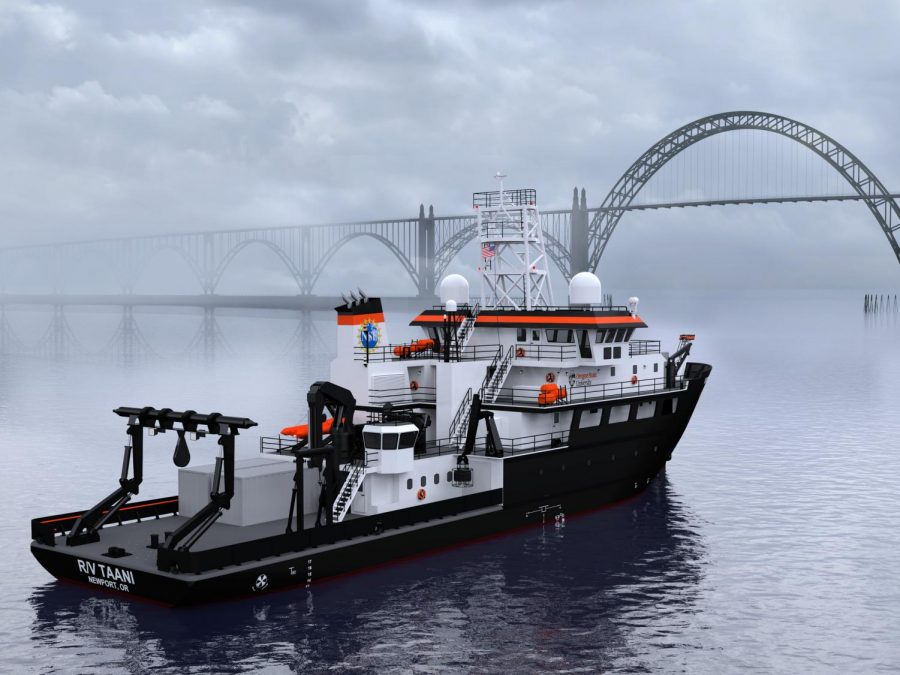Regional Class Research Vessel introduces new tool for increasing data science literacy
Courtesy of Oregon State University
This image shows an artistic rendition of Oregon State University’s Regional Class Research Vessel “Taani,” which will improve data and science literacy through the use of reall-time data transfer and communication. Taani is expected to aunch in March 2022.
January 3, 2022
Oregon State University leads a project focused on enhancing cutting-edge oceanic research and marine and data science education through the design and construction of three new ocean-going research ships.
The Regional Class Research Vessel program, funded by the National Science Foundation, will enhance public marine and data science literacy by adapting ocean science data for the development of educational programs and exhibits.
“Taani,” which means “offshore” in Siletz Dee-Ni, the official language of the Confederated Tribes of Indigenous Siletz peoples, was the first of the three RCRVs approved by the NSF for design and development.
According to the RCRV schedule summary, the construction of “Taani” has been underway since 2017, and in October of this year, OSU published a video outlining the advanced technological capabilities onboard the ship and how they will enhance oceanographic research and education.
In collaboration with outreach organizations throughout the state of Oregon, “Taani” is being outfitted to serve as a vessel for marine education. Access to a fully equipped RCRV will enable educators to develop hands-on science lessons for students interested in learning more about the marine environment.
The continuously operating high-speed satellite connectivity planned for “Taani” sets it apart from older generations of research vessels that have limited communication capabilities while at sea due to their dated technology.
Around the clock satellite connectivity onboard “Taani” will allow for real-time data transfer and communication with groups onshore. Researchers will be able to engage with educators and students during an expedition, offering insights into the world of marine science.
Live-streaming data is one of the benefits of the new data presence system, but should be approached with caution in regards to public use, said Tracy Crews, marine education program manager at Oregon Sea Grant.
Crews likened the high-throughput data streaming to drinking water from a fire hose, meaning students or other public users are likely to be overwhelmed by the sheer amount of data and will need additional help to make sense of it.
According to Crews, the data transfer system will allow for dozens of oceanographic and atmospheric instruments to simultaneously live-stream data, occuring at a pace and volume beyond the capacity of what students are capable of working with.
“Too much data can result in over-pumping the [data] stream,” Crews said. “A lot of work needs to happen before students can utilize the live data- streaming technology.”
According to Flaxen Conway, director of the Marine Resource Management program at OSU, tackling the issues of data science literacy is the first step in developing a more thorough understanding of marine science. In reality, most students don’t know the basic fundamentals of how to use and interpret data.
“How are you going to build a house if you don’t have a solid foundation?” Conway asked. “The first step is improving data literacy and then we can use the equipment at hand.”
Data from the RCRV will be vetted first so that it can be used for educational purposes, according to Crews. Outreach organizations working with OSU and the RCRV program have already started thinking about effective ways in which they will make these data available to students.
The Oregon Marine Scientist and Educator Alliance, or ORSEA, is one such program, funded by Oregon Sea Grant and the NSF, that plans to utilize oceanographic data by pairing marine researchers with public educators to develop age-appropriate activities centered around marine and data science.
Other collaborators, including the Science & Math Investigative Learning Experiences program at OSU, are developing fun and innovative programs that highlight the RCRV technology and its potential uses. According to Dr. Adam Talamantes, program coordinator at SMILE, public date literacy is important.
“We all live in a data-rich world and data literacy is a must have skill,” he said. “Researchers, teachers, and youth need to understand how they participate in the data stream.”
Going beyond the scope of marine science, outreach leaders for the RCRV program hope that students will gain a better appreciation for how data is used in everyday life. As data literacy progresses, they envision a day when the live-streaming capabilities onboard ‘Taani’ can be used to their full potential.
In response to the COVID-19 pandemic, an NSF report states construction of the RCRVs is expected to be delayed by six months, adding about $20 million to the existing cost of $354 million to build the ships.
According to the RCRV schedule summary, the new launch date for “Taani” is predicted to be in March 2022. The other two RCRVs are expected to launch in six-month increments after “Taani” and by February 2023.




















































































![Newspaper clipping from February 25, 1970 in the Daily Barometer showing an article written by Bob Allen, past Barometer Editor. This article was written to spotlight both the student body’s lack of participation with student government at the time in conjunction with their class representatives response. [It’s important to note ASOSU was not structured identically to today’s standards, likely having a president on behalf of each class work together as one entity as opposed to one president representing all classes.]](https://dailybaro.orangemedianetwork.com/wp-content/uploads/2025/03/Screenshot-2025-03-12-1.00.42-PM-e1741811160853.png)























